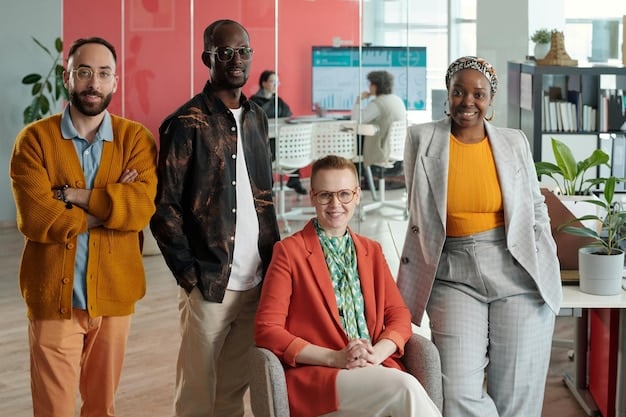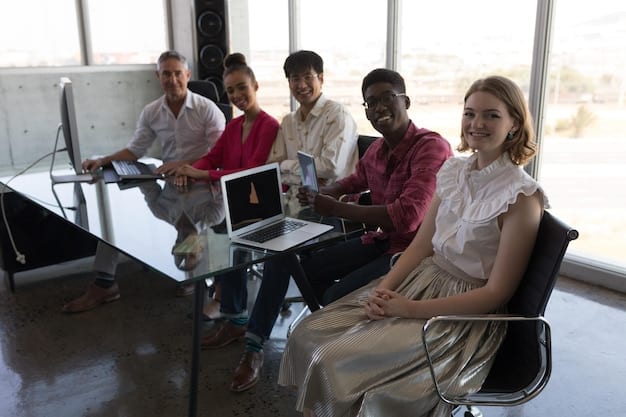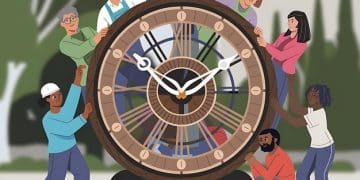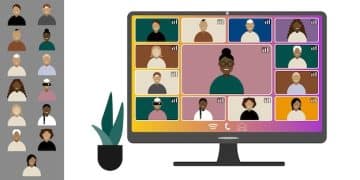US Cultural Diversity & Team Dynamics: Strategies for Inclusive Collaboration

The profound influence of United States cultural diversity on team dynamics necessitates focused strategies for inclusive collaboration to foster innovation, improve problem-solving, and enhance organizational resilience.
In today’s interconnected world, the United States stands as a vibrant tapestry of cultures, and this rich diversity is increasingly reflected within professional teams. Understanding The Impact of US Cultural Diversity on Team Dynamics: Strategies for Inclusive Collaboration is not merely an academic exercise; it is a strategic imperative for organizations aiming to thrive in an evolving global landscape.
Understanding the Facets of US Cultural Diversity in Teams
The concept of diversity within US teams extends far beyond surface-level demographics. It encompasses a complex interplay of visible and invisible differences that shape individual perspectives, communication styles, and work approaches. This rich tapestry demands a nuanced understanding from leaders and team members alike.
Surface-Level and Deep-Level Diversity
Surface-level diversity refers to observable characteristics like race, ethnicity, age, and gender. While these are important, deep-level diversity—which includes values, beliefs, attitudes, experiences, and cultural norms—often has a more profound and subtle impact on team interactions. Recognizing both dimensions is crucial for effective collaboration.
- Visible Traits: Age, gender, ethnicity, physical abilities.
- Invisible Traits: Education, socioeconomic background, religious beliefs, sexual orientation, political views.
- Cognitive Diversity: Different ways of thinking, problem-solving, and perceiving information.
The United States’ unique history as a nation of immigrants means that these diverse elements are not just present but are deeply woven into the fabric of its workforce. Teams operating within this context often encapsulate micro-societies, each reflecting broader national and global cultural trends. Navigating these differences requires a proactive and empathetic approach, moving beyond mere tolerance to genuine appreciation.
Understanding these different facets means acknowledging that a team member’s cultural background, whether from a specific US region, an immigrant community, or a subculture, will influence their interactions. For instance, an individual’s upbringing might dictate their comfort level with direct feedback versus indirect communication, or their preference for individual achievement versus collective success. These subtle variations, when understood, can become powerful levers for team synergy rather than sources of friction.
The Double-Edged Sword: Benefits and Challenges of Diverse Teams
While diversity is often lauded for its potential benefits, ignoring the inherent challenges it presents can lead to pitfalls. A balanced perspective is essential to harness the strengths and mitigate the weaknesses within culturally diverse teams.
Unlocking Innovation and Problem-Solving
Culturally diverse teams bring together a wider range of perspectives, experiences, and knowledge bases. This cognitive diversity is a powerful catalyst for innovation, leading to more creative solutions and robust decision-making. Different viewpoints challenge assumptions and encourage out-of-the-box thinking.
- Enhanced Creativity: Exposure to varied perspectives sparks new ideas.
- Better Problem-Solving: Diverse teams identify more angles and solutions.
- Improved Decision Making: Broader input leads to more comprehensive assessments.
- Market Relevance: Teams mirroring customer diversity better understand diverse markets.
Imagine a marketing team developing a campaign for a national product. A homogeneous team might miss cultural nuances important to significant segments of the US population. A diverse team, however, is more likely to anticipate various reactions, understand distinct consumer behaviors, and craft messaging with broader appeal. This direct correlation between team composition and market penetration is a tangible benefit of diversity.
Navigating Communication Barriers and Conflict
On the flip side, cultural differences can create communication barriers, misunderstandings, and even conflict. Varying communication styles, non-verbal cues, and approaches to hierarchy or conflict resolution can lead to friction if not properly managed. What might be considered direct and efficient in one culture could be perceived as aggressive in another.
For example, cultures that prioritize harmony might avoid direct confrontation, opting for subtle hints or third-party mediation. Conversely, cultures that value directness might misinterpret such indirectness as lack of commitment or passive aggression. These discrepancies, if left unaddressed, can erode trust and productivity. Moreover, unconscious biases, even well-intentioned ones, can surface, impacting hiring, promotion, and daily interactions.

Establishing a Foundation for Inclusive Collaboration
Building truly inclusive teams requires more than just acknowledging diversity; it demands intentional effort and strategic foundational elements. These elements range from leadership commitment to fostering psychological safety.
Leadership Commitment and Role Modeling
Inclusive collaboration begins at the top. Leaders must not only articulate the value of diversity but also actively model inclusive behaviors. This includes practicing active listening, demonstrating empathy, promoting equitable opportunities, and openly addressing biases within the team and organization.
- Visible Advocacy: Leaders champion diversity initiatives and policies.
- Behavioral Modeling: Leaders demonstrate inclusive language and actions.
- Accountability: Leaders hold themselves and others accountable for inclusive practices.
When leadership consistently shows that inclusive practices are a core value, it signals to the entire organization that these behaviors are expected and rewarded. This top-down reinforcement helps to embed inclusivity into the organizational culture, rather than it being seen as a passing trend or an isolated HR initiative. This consistent messaging creates an environment where team members feel safe and encouraged to bring their whole selves to work.
Fostering Psychological Safety and Trust
Psychological safety is paramount for diverse teams to thrive. It’s an environment where team members feel comfortable taking risks, admitting mistakes, and expressing dissenting opinions without fear of negative consequences. In diverse teams, this safety is even more critical as individuals from different backgrounds might have varying comfort levels with assertiveness or vulnerability.
Building trust involves transparent communication, consistent fairness, and genuinely valuing contributions from all team members. When team members trust each other and feel psychologically safe, they are more likely to share diverse perspectives, engage in healthy debate, and ultimately contribute more effectively to team goals. Trust serves as the bedrock upon which meaningful cross-cultural collaboration can be built.
Key Strategies for Enhancing Team Dynamics
Translating the understanding of diversity into actionable strategies is where inclusive collaboration truly takes shape. These strategies focus on communication, education, and structured team activities.
Cultivating Cross-Cultural Communication Skills
Effective communication is the linchpin of any successful team, and in culturally diverse settings, it requires an extra layer of awareness and skill. This means moving beyond simply speaking the same language to understanding different communication nuances.
- Active Listening: Pay full attention, interpret non-verbal cues.
- Clarity and Directness: Minimize jargon, ensure messages are clear.
- Contextual Awareness: Understand high-context vs. low-context cultures.
- Feedback Sensitivity: Adapt feedback delivery based on cultural norms.
Training programs focused on cross-cultural communication can be immensely beneficial, helping team members to recognize their own communication biases and learn to adapt their styles. This might involve exercises where team members role-play different scenarios, or discussions about real-life examples of miscommunication. The goal is not to eliminate differences but to equip individuals with the tools to navigate them effectively and empathetically.
Implementing Diversity and Inclusion Training
Formal training programs play a crucial role in raising awareness, challenging unconscious biases, and providing practical tools for inclusive behavior. These trainings should go beyond basic awareness to foster genuine understanding and behavioral change.
Effective training covers topics such as unconscious bias, microaggressions, cultural competency, and allyship. It should be interactive, scenario-based, and ongoing, rather than a one-off event. The objective is to provide a safe space for learning and self-reflection, helping individuals to identify and address their own biases and to better understand the experiences of others. This ongoing education is a continuous journey, not a destination.

Practical Applications and Best Practices
Moving from theory to practice involves integrating inclusive strategies into the daily operations and long-term planning of teams and organizations. These practical steps ensure diversity is not just celebrated but actively leveraged.
Inclusive Recruitment and Onboarding Processes
The journey of inclusive collaboration begins even before a team member joins. Recruitment strategies should actively seek out diverse talent pools, utilizing blind resume reviews or skills-based assessments to minimize bias. Once hired, onboarding processes must be designed to make diverse individuals feel welcome and integrated from day one.
This means providing mentors, clearly explaining cultural norms of the workplace, and ensuring that new employees feel their unique perspectives are valued. An inclusive onboarding process helps to overcome initial feelings of being an “outsider” and accelerates the integration of new team members into the existing dynamics. It sets the tone for a welcoming and equitable environment.
Creating Inclusive Meeting and Decision-Making Processes
Meetings are a microcosm of team dynamics, and it’s essential to design them for inclusivity. This involves practices that ensure all voices are heard and valued, especially those from underrepresented backgrounds or quieter team members.
Strategies include setting clear agendas beforehand, actively soliciting input from all participants, using tools for anonymous feedback, and rotating roles such as meeting facilitator. For decision-making, consider practices like “fist-to-five” voting or soliciting input in written form before verbal discussion to ensure that more assertive personalities don’t dominate the conversation. Inclusive processes lead to more robust decisions because they incorporate a wider range of perspectives.
Measuring Success and Sustaining Inclusion
Inclusion is an ongoing journey, not a fixed destination. To ensure strategies are effective and progress is sustained, organizations must commit to continuous evaluation and adaptation.
Gathering Feedback and Data
Regularly solicit feedback from team members regarding their experiences with diversity and inclusion. This can be done through anonymous surveys, focus groups, or one-on-one discussions. Data on employee satisfaction, retention rates, promotion rates, and diversity metrics are crucial indicators of success.
Analyzing this data helps to identify areas for improvement, pinpoint specific challenges within teams, and measure the impact of implemented strategies. What gets measured gets managed, and in the realm of diversity and inclusion, data provides the objective evidence needed to justify continued investment and course correction.
Continuous Learning and Adaptation
The cultural landscape of the US is constantly evolving, as are global best practices in diversity and inclusion. Organizations and teams must foster a culture of continuous learning and adaptation. This involves staying informed about new research, adjusting strategies based on feedback and data, and being prepared to challenge existing norms.
Workshops, seminars, and access to resources on cultural competency should be ongoing. Creating internal communities of practice or affinity groups can also support continuous learning and peer support. Sustaining an inclusive environment requires vigilance, flexibility, and a deep commitment to ongoing growth and development.
| Key Aspect | Brief Description |
|---|---|
| 💡 Innovation Boost | Diverse perspectives lead to creative problem-solving and new ideas. |
| 🗣️ Communication Nuances | Varying styles require cultural awareness and adaptive communication. |
| 🤝 Inclusive Practices | Leadership commitment, psychological safety, and fair processes are key. |
| 📈 Continuous Improvement | Regular feedback and ongoing training are vital for sustained inclusion. |
Frequently Asked Questions about Diverse Team Dynamics
▼
Cultural diversity within US teams is crucial because it brings together a wider array of perspectives, experiences, and problem-solving approaches, fostering innovation and enhancing decision-making. It also helps teams better understand and serve a diverse customer base in the United States.
▼
Common challenges in culturally diverse teams include communication barriers due to differing styles, potential for misunderstandings or conflict, and the emergence of unconscious biases. Navigating these requires intentional strategies and open dialogue to prevent friction and promote synergy.
▼
Leaders can promote inclusive collaboration by demonstrating visible commitment to diversity and inclusion, modeling inclusive behaviors, and fostering psychological safety within their teams. This involves active listening, equitable opportunity distribution, and consistently valuing all team members’ contributions.
▼
Communication is paramount in diverse team dynamics. Effective cross-cultural communication skills, including active listening and sensitivity to different communication styles (e.g., direct vs. indirect), help mitigate misunderstandings and build stronger relationships. Training can significantly enhance these crucial skills.
▼
Organizations can measure success through various metrics such as employee satisfaction surveys, retention and promotion rates for diverse talent, and feedback from inclusion-focused focus groups. Continuous data collection and analysis help identify what’s working, where improvements are needed, and how to adapt strategies effectively over time.
Conclusion
The impact of US cultural diversity on team dynamics is undeniable, presenting both rich opportunities and unique challenges. By embracing intentional strategies for inclusive collaboration, organizations can transform potential hurdles into powerful competitive advantages. From fostering psychological safety and empowering leadership to cultivating refined communication skills and implementing data-driven practices, the journey toward truly inclusive teams is continuous but essential for innovation, employee engagement, and sustained success in a diverse nation.





